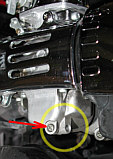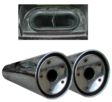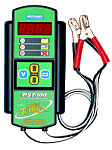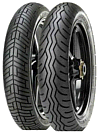|
If you live in a place that experiences a cold climate for part of the year, you may have to be concerned with "winterizing" your motorcycle. Some people have the good fortune to live in an area that has nothing but warm weather all year long but even those lucky b*****ds would need to take certain steps to protect their motorcycles during periods of long-term storage. For everyone, time has a way of taking its toll.
Most motorcycle owners already have a ritual they like to follow when it comes time to park their motorcycles for the season but for those who have never done it before, I've compiled this list of tips for winterization & long-term storage. Please bear in mind that this list isn't tailored to anyone in particular. It's as complete as possible without consideration of individual circumstances. These tips won't apply to everyone so read selectively, keeping your personal circumstances in mind.
14 Winterization Tips
|
 |
 |
 |
|---|
 |
1. Antifreeze:
It seems obvious to say that you need antifreeze to winterize but even that can be overlooked. Antifreeze is critical for winterization, especially if you live in a cold climate where the temperature might drop as low as -20°C (-4°F) or less. That sort of temperature is nearing the limit of typical mixtures of antifreeze so it's worth having a closer look at your particular mixture. Antifreeze isn't as critical for warm-weather long-term storage but, nevertheless, it shouldn't be forgotten. Whether warm or cold, corrosion can be a problem in addition to freezing so a good antifreeze (aka coolant) is always a good idea. Where the Maxim-X is concerned, it's important to choose a type of antifreeze which is specifically designed for aluminum engines, which is ethylene glycol based and which contains NO SILICATES. Silicates can damage our Maxim-X engines in a number of unwanted ways so they need to be avoided. If you find a coolant that declares LOW SILICATES, that's just another way of saying that it contains some of what you don't want so that wouldn't be appropriate. Personally, I use Havoline Dex-Cool. I buy the concentrated type rather than the premixed type because it allows me to play with the mixture to lower the freezing point but that's just my preference. Any ethylene glycol based, aluminum-safe, silicate-free antifreeze will probably suffice. |
 |
|---|
 |
2. Stabilize Fuel:
Long before winter ever rolls around, I start using fuel stabilizer in the gas tank. It prevents the fuel from breaking up and turning into varnish in your carbs. It also helps prevent freezing so I like to start adding it early - that way I'm not caught off guard. There's no harm in using stabilizer in your fuel year-round if you want although it won't serve any useful purpose. By the way, before you go shopping for fuel stabilizer, you should know that some brands are better than others. Here are some pictures of Canadian Tire's Motomaster brand of fuel stabilizer which sat in the cold of my garage for only a week or so before I took this picture. I had to wonder...if it can't stabilize itself, how will it stabilize my fuel? My preferred brand was STABIL until I realized that SeaFoam is also a fuel stabilizer. |
 |
|---|
 |
3. Fill Gas Tank:
Always FILL your gas tank to its fullest capacity over the winter. The tank isn't usually coated on the inside - it's bare metal so any part that's exposed to air will eventually rust. Leaving only a minimal amount of fuel in the tank all winter long or during extended periods of storage is a sure way to promote corrosion. Instead, fill up the tank as far as possible so fuel will coat as much of the otherwise exposed metal as possible. This won't help prevent the bare upper surface from rusting but it will keep surface exposure and related corrosion to a minimum.
|
 |
|---|
 |
4. Drain Float Bowls:
Some people like to drain their carburetor float bowls over the winter. Many people still do so without any real idea why they're doing it. It has just become a ritual that usually doesn't do much apart from exposing aluminum that would otherwise be covered by fuel. Historically, float bowls were drained to prevent the fuel in the bowls from breaking down, forming varnish and clogging the jets. That, however, was only a concern before the need for fuel stabilization was understood and before fuel stabilizers became common & readily available. With a fuel stabilizer circulated through the fuel system, float bowls aren't likely to encounter the same fuel consistency problems that led to their being drained in the past. However, another reason for draining the float bowls is related to extremely cold weather. Although gasoline itself has to be pretty darn cold before it will freeze (starts to gel at -97°F/-72°C and last component freezes at -300°F/-184°C), we don't always have just gasoline in our tanks and carbs. There's often a small amount of water mixed in with the gasoline which will settle out and freeze a lot sooner. That's why gasline antifreeze exists. As it turns out, SeaFoam does essentially what gasline antifreeze does so if you've already added SeaFoam to your fuel as a stabilizer then freezing won't be an issue. But, if you've negelected to look after your winterization checklist, you might conceivably end up with some small amount of water in your float bowls which would freeze unless the bowls were drained. Still, the amount of water would only be very small and wouldn't have an appreciable effect, even if frozen. As for fuel passages... water's density causes it to settle below gasoline so moisture isn't likely to remain in any fuel passages where larger accumulations could freeze, expand and do damage - at least not in the Maxim-X Mikunis. There would have to be some pretty extraordinary circumstances for carb damage to occur from freezing as a result of not draining the float bowls. Whether the concern is fuel degradation or freezing, SeaFoam makes it unnecessary to drain the bowls and even without it, the benefit of draining the float bowls is minimal at best.
|
 |
|---|
 |
5. Cylinder Corrosion Protection:
There isn't usually a lot of oil coating the cylinder walls above your pistons - the engine is designed to prevent that sort of thing. As such, when you park your bike, your cylinder walls are left unprotected from the environment. Given enough time, the cylinder walls will begin to rust and if they're left to rust long enough you might end up doing serious damage. For that reason, it's a good idea to fog your cylinders with oil before parking the bike over the winter months or during extended periods of storage. Oil foggers come in the form of a spray can and can be purchased just about anywhere for only a few dollars. Just park your bike, pull the spark plugs and spray the oil fogger into each cyclinder before replacing the spark plugs. The resulting thin coat of oil will help protect the cylinder walls until the motorcycle comes out of storage.
|
 |
|---|
 |
6. Seal Intake & Exhaust:
Since corrosion is such a big issue when storing your bike, some people also advocate sealing your intake and exhaust openings. To seal the intake on the Maxim-X, just remove the seat and fasten a freezer bag over the airbox intake using an elastic band - the intake protrudes just enough to get an elastic band around the base so it's fairly easy to do. Similarly, to seal the exhaust, stretch a freezer bag over each muffler and fasten them with elastic bands. I'm not sure that you'd accomplish much by doing this but if you do choose to seal your intake & exhaust, there are three (3) things that need consideration. First, a sealed airbox intake might lead to more trouble than it's worth. If you forget about it and try starting the bike in the spring, that plastic bag might cause some real grief. Second, it might be a good idea to use cylinder fogging oil to fog as much of the inside of your pipes as possible before sealing off the mufflers. Third, even if you're not concerned about protecting your exhaust from the elements, sealing the mufflers is still a good idea if only to keep the rodents out  . Apparently it happens more often than we'd like to believe. |
 |
|---|
7
|
Periodic Run-up:
Many motorcycle owners say it's a good idea to periodically start & run your bike during long term storage. The idea is to keep fuel flowing through the carbs, to circulate some oil and keep the cylinders from corroding, to burn off any accumulated condensation and to charge up the battery. Those are good intentions but in reality it may do more harm than good depending on the climate you live in and the oil in your crankcase. If your bike is being stored in a warm environment then periodic starting is a great idea, particularly to keep the engine seals from drying out and leaking. If your bike is being stored in a cold environment, however, then periodic runups could lead to unexpected damage if you haven't prepared properly. In excessively cold weather, oil doesn't start circulating as immediately as is would in warmer weather, and thicker cold oil also won't pass through an oil filter as easily as when it's warmed up. Sure, the oil will eventually warm up and circulation will improve to what it should be, but the lesser lubrication in the beginning moments of a cold run-up won't do anything favourable for your engine and could be harmful, especially with the wrong oil. There are also those who warn that winter run-ups can actually *increase* the amount of condensation in the crankcase rather than burning it off and will also lead to the buildup of acids and such in the oil. From most perspectives, it seems that the periodic run-up concept is a bad one. Besides, I've come to realize that intentions are one thing and reality is something different - plans to periodically run-up the bike might be forgotten. Also, if you've removed your battery, sealed your intake/exhaust or fogged your cylinders, then a run-up only becomes awkward. When my X is actually stored for a length of time (which isn't often), I prefer not to run it up and I deal with the supposed run-up benefits (fuel & oil circulation, cylinder corrosion protection, battery charging, etc.) separately... but that's just me.
|
 |
|---|
8
|
Winter Oil & Filter:
If you're like me and you intend to ride through the winter months or if you plan to start & run your bike from time to time, then you should make some changes where the oil is concerened. Most engine wear happens in that brief moment immediately after starting when the engine oil hasn't yet begun to circulate properly. In the cold of winter, oil doesn't flow as well as it normally would so starting the engine with a summer oil still in the crankcase might cause unexpected wear from the slower onset of lubrication. For that reason, if you're planning periodic run-ups during winter storage, it might be a good idea to do an oil & filter change with a more appropriate winter oil just before the bike goes into storage.
|
 |
|---|
 |
9. Battery Maintenance:
Equip yourself with a Trickle Charger which is also a Minder/Maintainer - a simple Trickle Charger won't do. For best results, you'll need a charger which you can leave connected indefinitely which will monitor the battery voltage and adjust its level of charge accordingly. Canadian Tire sells a good Charger/Minder (the one I have) for CAD $50 and sometimes it even goes on sale for a very reasonable CAD $22.95. In most cases it's probably sufficient to connect your Trickle Charger/Minder with the battery still in the motorcycle but personally, I like to remove the battery for maintenance inside, in my warm basement. That makes it a little more convenient to look in on the battery from time to time and to refill it with distilled water when necessary. Some people are afraid to leave their batteries connected to a Trickle Charger/Minder all winter long (or as long as the bike is stored). That's a valid concern where standard Trickle Chargers are in use but as long as your charger is a Minder/Maintainer as well, it's perfectly safe to leave the battery hooked up unattended almost indefinitely (as long as the Minder circuit is working  ). I follow this routine regularly and as a result, my battery life is regularly in excess of ten years.... I guess I must be doing something right. |
 |
|---|
 |
10. Prevent Tire Flat Spots:
To protect the tires from developing flat spots, put the bike on the centre stand then prop an appropriately long piece of wood (2"x4") under the lateral frame rail by the front of the engine to take weight off the front wheel without shifting it to the back. The idea is to have the centre stand & wood block carry the full weight of the motorcycle with none carried by the tires. Some people prefer to prop up the forks at the front axle instead because the supporting wood takes a lot less force up there and because it keeps normal pressure on the forks and seals. Personally, I can't see an appreciable benefit of one over the other. As long as the tires are off the ground, front & back, that's the main thing.
|
 |
|---|
11
|
Wash, Polish & Protect:
It's a good idea to give the bike a thorough cleaning before storage - especially the chrome parts. The pipes seem to like to rust more quickly than anything else so it's a good idea to clean them with chrome polish of some kind. It will remove small amounts of rust, inhibit further rusting and leave a thin protective coating. I like Turtle Wax Chrome Polish and Autosol. As far as I'm concerned they're the best products and easiest to use. You can buy Turtle Wax Chrome Polish at Wal-Mart but Autosol is a little more difficult to find. It's carried by some bike shops but not all of them. Of course, the rest of the bike's finish should be looked after as well. A little wax on the finish and some leather treatment on the seat are two key areas. I also like to spray some rust inhibitor on some of the areas of the frame that are beginning to rust just to slow the process down.. Many people will also coat all exposed metal (except, of course, the brake rotors) with WD-40 or something similar but that may be excessive. If you've cleaned & polished well and have used good products to do so, you should be OK. Most cleaning & polishing products leave behind a protective film that should make coating everything with WD-40 completely unnecessary. Besides, cleaning up the WD-40 mess in the spring isn't on my list of favourite things to do.
|
 |
|---|
12
|
Park on Non-Porous Surface:
Some people will put down a tarp on their garage floor and then park their bike on it. The idea is that the moisture coming up through the concrete floor won't have as direct an effect on the bike. I used to do it but not anymore because I just can't convince myself that the ambient humidty is any different. Still, it's done by some people and it certainly couldn't hurt.
|
 |
|---|
13
|
Motorcycle Cover:
Naturally the bike should go indoors (garage for instance), preferably under a bike cover.
|
 |
|---|
14
|
Lockup Your Bike:
It's a sad testiment to the state of today's society but if your bike remains stored or parked in the same place for any length of time, you might risk losing it if it isn't locked up tight. Especially in cases where you're forced to store your bike far from sight, take the time to lock it up in one way or another. Storage just isn't the same if there's no bike to take out of storage.
|
 |
|---|
 |
 |
|